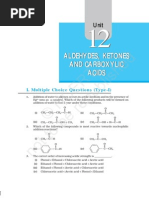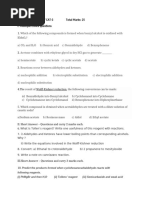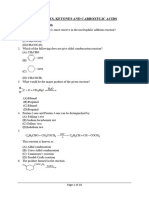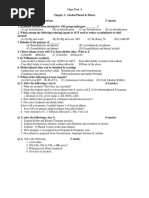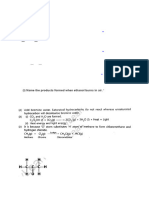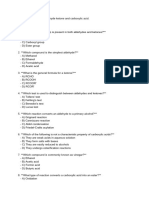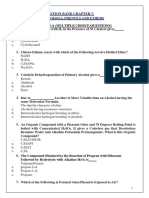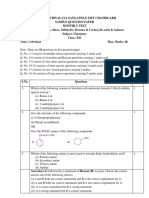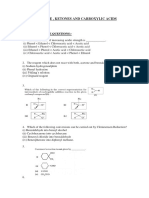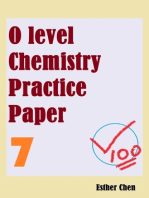Key Quiz Ch14
Uploaded by
Marci McElhinny CirellKey Quiz Ch14
Uploaded by
Marci McElhinny CirellCHEM-102 Chapter 14 Quiz Name : __________KEY______________
July 20, 2011
Banner ID : _________________
MULTIPLE CHOICE QUESTIONS (10 points: each question is worth 1 points)
d 1. What is the name of the following structure? a. ethyl isopropyl aldehyde b. ethyl isobutyl aldehyde c. 2-methyl-4-hexanone d. 5-methyl-3-hexanone 2. Which structure represents benzaldehyde?
OH
O
O
a. a
b.
c.
3. Pick the one answer below that shows compounds in order of lowest to highest solubility: a. alkane, aldehyde, alcohol b. aldehyde, alkane, alcohol c. alcohol, aldehyde, alkane 4. What is the product of methyl methyl ketone (aka acetone) with the permanganate ion? a. acetic acid b. methanol c. hemiacetal d. acetal e. no reaction 5. What is the condensed structural formula of acetaldehyde? a. CH3-CHO b. CH3CH2-CHO c. H-CHO d. CH3-COOH 6. What is the condensed structural formula of propanone? a. CH3-CHO b. CH3CH2-CHO c. H-CHO d. CH3-COOH
e. CH3-CO-CH3
e. CH3-CO-CH3
7. Benedicts reagent will oxidize with which of the following compounds? a. any aldehyde b. any ketone c. -hydroxy ketone d. -hydroxy aldehyde
e. c & d
8. During a hydride reduction, which statement below is correct? a. a hydride ion is created by LiAlH4 to attack the carbonyl oxygen first; a proton from H2O attacks carbon next b. a hydride ion is created by H2O to attack the carbonyl carbon first; a proton from LiAlH4 attacks oxygen next c. a hydride from LiAlH4 and a proton from H2O attack the carbonyl group at the same time d. a hydride from LiAlH4 first attacks the carbonyl carbon, then a proton from H2O attacks the oxygen last 9. Both hemiacetals and acetals contain the functional group O-CH3 . This is called what? a. methanol group b. methoxy group c. oxymethane group d. methaldehyde group
f 10. Which of the following compounds will react with permanganate or dichromate ions to change color (i.e., oxidize to a different compound)? a. alkene b. aldehyde c. ketone d. primary alcohol e. b & d f. a,b, & d
You might also like
- Aldehydes Ketones and Carboxylic Acids MPNo ratings yetAldehydes Ketones and Carboxylic Acids MP17 pages
- 12 - Cbs - Aldehydes Ketones Carboxylic AcidsNo ratings yet12 - Cbs - Aldehydes Ketones Carboxylic Acids6 pages
- Grade 12 CAT 5 Aldehyde Ketone Carboxylic AcidNo ratings yetGrade 12 CAT 5 Aldehyde Ketone Carboxylic Acid2 pages
- 12TH CLASS CHAPTER WISE QP 2022-23-104-123No ratings yet12TH CLASS CHAPTER WISE QP 2022-23-104-12320 pages
- 100 MCQS on Aldehydes, Ketones, and Carboxylic AcidsNo ratings yet100 MCQS on Aldehydes, Ketones, and Carboxylic Acids17 pages
- Unit 8,9 and 10 Worksheet - QUESTION BANK GR 12No ratings yetUnit 8,9 and 10 Worksheet - QUESTION BANK GR 1225 pages
- Organic Chemistry Solutions for ICSE Board Class 10 Science (Concise - Selina Publishers)No ratings yetOrganic Chemistry Solutions for ICSE Board Class 10 Science (Concise - Selina Publishers)74 pages
- Sr Chemistry Worksheet 04-04-25 to 17-04-2025 (2)No ratings yetSr Chemistry Worksheet 04-04-25 to 17-04-2025 (2)29 pages
- ĐỀ 2 - ĐỀ ÔN TẬP CUỐI KÌ 2 HÓA 11 (Theo Minh Họa 2025)No ratings yetĐỀ 2 - ĐỀ ÔN TẬP CUỐI KÌ 2 HÓA 11 (Theo Minh Họa 2025)8 pages
- CH-4 Carbon and Its Compounds AssignmentNo ratings yetCH-4 Carbon and Its Compounds Assignment7 pages
- Aldehydes Ketones and Carboxylic Acid AssignmentNo ratings yetAldehydes Ketones and Carboxylic Acid Assignment3 pages
- Chemistry Xii NAME: - : Alcohol, Phenol & Ether100% (1)Chemistry Xii NAME: - : Alcohol, Phenol & Ether1 page
- Class 12chemistry - Alcohol, Phenol and Ether - McqsNo ratings yetClass 12chemistry - Alcohol, Phenol and Ether - Mcqs22 pages
- Organic Chemistry CHM 102 Fall 2011 Midterm Exam Model Answer IKNo ratings yetOrganic Chemistry CHM 102 Fall 2011 Midterm Exam Model Answer IK10 pages
- Monthly Test Xii Chemistry October 2023-24No ratings yetMonthly Test Xii Chemistry October 2023-244 pages
- msbshse-solutions-class-12-chemistry-chapter-11-alcohols-phenols-and-ethers (3)No ratings yetmsbshse-solutions-class-12-chemistry-chapter-11-alcohols-phenols-and-ethers (3)9 pages
- Important Questions for Class 12 Chemistry Chapter 12 Aldehydes, Ketones and Carboxylic Acids Class 12 Important Questions - Lea 2No ratings yetImportant Questions for Class 12 Chemistry Chapter 12 Aldehydes, Ketones and Carboxylic Acids Class 12 Important Questions - Lea 21 page
- Aldehyde, Ketones and Carboxylic Acids: Multiple Choice QuestionsNo ratings yetAldehyde, Ketones and Carboxylic Acids: Multiple Choice Questions3 pages





